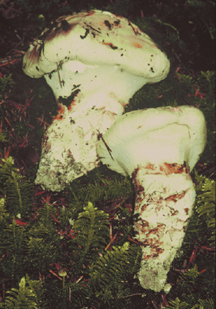

SilviShrooms
Predicting edible mushroom productivity using forest carbon allocation modeling and immunoassays of ectomycorrhizae




Mycorrhizal fungi
Fungi that form nutrient exchange structures called mycorrhizae
(literally "fungus-roots") with healthy plant rootlets.
The relationship is symbiotic in the sense that it is mutually
beneficial, although to varying degrees. The fungus extends hyphae
(one-cell wide fungal "threads") away from the mycorrhizae
to form a fine network of absorption and then translocates absorbed
mineral nutrients and water to the plant. As such, the fungus
acts as a fine root system for the plant. The plant in return
provides the mycorrhizal fungus with carbohydrates it has produced
through photosynthesis. (See Trappe 1996
for a more precise definition).
Ectomycorrhizal (EM) fungi
A subset of mycorrhizal fungi that form a characteristic fungal mantle or sheath on the small root tips of certain trees (predominantly tree species in the Pinaceae and Fagaceae). Many prized forest mushrooms such as chanterelles, matsutake, boletes, truffles, and others are ectomycorrhizal species and therefore derive their carbohydrate nutrition from the host trees through this symbiotic relationship. Sample photographs of EM fungi.
Gross Primary Productivity (GPP)
Total quantity of carbon fixed through photosynthesis in the form of carbohydrates or other metabolic compounds.
Net Primary Productivity (NPP)
Net quantity of carbon available to the tree or its mycorrhizal fungus partners for growth or other functions after subtracting the amount used for tree respiration (maintenance metabolism). Net primary productivity is a relatively constant 47%, of gross primary productivity across a wide range of forest types and conditions.
Belowground Allocation
The proportion or amount of net primary productivity that
the tree allocates for large structural roots, fine feeder roots,
and mycorrhizal symbionts.
Fruiting Potential
The maximum productivity that is possible on a given site in a
given year if weather is favorable for mushroom development during
the fruiting season.
Average Site Productivity
The average mushroom productivity of a site over 4-10 years, measured in kg/ha/yr or equivalent units. This variable provides a mean of expressed fruiting potential by averaging across multiple years of annual variation in weather patterns during the fruiting seasons. Conversely, 4-10 years is a sufficiently short interval that natural changes in stand conditions should not unduly interfere with deriving correlations for our model.
Site Occupancy
The percentage of potential habitat that is occupied by the edible
EM fungal species of interest relative to competing EM fungi as
measured by the percentage of EM root tips colonized by the species
of interest or by the spatial extent of its mycelium.